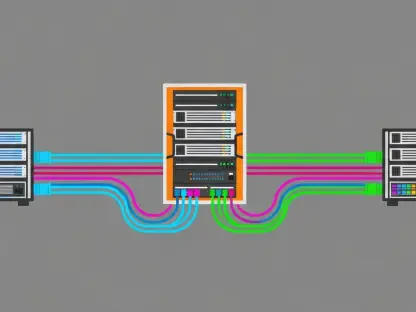Quantum networking is a rapidly evolving field that holds the promise of revolutionizing how we connect and secure our digital world. Recent advancements by American and European companies have addressed core technical challenges, bringing us closer to scalable quantum computing. The Quantum Summit hosted by Cisco showcased the latest progress in distributed quantum computing, highlighting the potential of linking quantum chips, computers, and enterprise data centers.
Emerging as a groundbreaking development with the potential to transform the landscape of technology, quantum networking aims to harness quantum mechanics to create highly secure, efficient, and resilient communication systems. As experts and researchers from academia, government, and industry converge to push the boundaries of what is possible, we stand on the brink of a new era in digital connectivity. This article examines the strides being taken in the quantum networking field, highlights key projects and technological developments, and explores the competitive landscape of global quantum communication efforts.
The Promise of Distributed Quantum Computing
Distributed quantum computing endeavors to create networks of quantum computers that can work together to solve complex problems more efficiently than classical computers. This approach is not just about performing computations faster; it leverages the unique properties of quantum mechanics, such as entanglement and superposition, to tackle problems that would be intractable for classical systems. Although still predominantly in the research phase, significant growth is expected in its application in the coming years as initiatives like the QUANT-NET project pave the way.
One exemplary project is the QUANT-NET initiative, which is developing a prototype for a distributed quantum network spanning 5 kilometers of fiber between Berkeley Lab and the University of California, Berkeley. This project aims to demonstrate the feasibility and advantages of linking quantum processors over distances to work collaboratively on tasks. The progress so far has been promising, and significant developments are anticipated in the upcoming months, showcasing the potential of such a network in real-world scenarios.
The ability of distributed quantum computing to offer unparalleled processing power presents exciting opportunities for various fields, including cryptography, materials science, and pharmaceuticals. By connecting multiple quantum processors, the realization of more scalable quantum computing becomes possible, overcoming the limitations of isolated quantum systems. As research advances and practical implementations come into focus, the promise of distributed quantum computing stands to revolutionize the way we approach solving some of the most complex and critical problems of our time.
Quantum Key Distribution: A Game Changer in Secure Communications
Quantum key distribution (QKD) is revolutionizing secure communications by leveraging the principles of quantum mechanics to ensure the safe exchange of encryption keys. Unlike classical methods, QKD utilizes quantum channels, providing a level of security that is fundamentally unbreakable due to the inherent nature of quantum particles. First commercialized in 2003, QKD has been increasingly adopted on an enterprise scale in the U.S., Europe, and China, marking a significant milestone in secure data transfer.
Several key players dominate the QKD market, including Toshiba, ID Quantique, LuxQuanta, HEQA Security, and Think Quantum. These companies are at the forefront of developing and deploying QKD technologies, making substantial contributions to the advancement of secure communication systems. One notable implementation of QKD can be observed in JPMorgan Chase, which has connected two data centers through a high-speed quantum network over fiber and established a third quantum node to test next-generation quantum technologies. This setup not only showcases the practical applications of QKD but also underscores the technology’s potential for enhancing security in critical financial networks.
As quantum computers approach practical usability, with the capability of potentially breaking current encryption standards, the need for secure quantum networks becomes increasingly urgent. Quantum key distribution, alongside quantum-safe encryption techniques, presents viable solutions to the impending security challenges. Juniper Research forecasts that network operators will invest over $6 billion cumulatively over the next five years in the development and implementation of QKD networks. This substantial investment reflects the growing recognition of QKD’s importance in ensuring data security in a quantum future.
The Financial Sector’s Interest in Quantum Networking
The financial sector, particularly firms like JP Morgan Chase, is showing significant interest in quantum networking. These institutions are at the forefront of adopting communication technologies that offer enhanced security and efficiency. The benefits of QKD, such as its commercial availability and ability to provide secure communication over existing optical networks, are particularly attractive to these organizations. By implementing QKD, financial institutions can safeguard sensitive information and transactions against potential threats posed by advanced quantum computing capabilities.
QKD’s potential for authentication and establishing proof of physical location adds another layer of utility that classical technologies cannot achieve. For instance, QKD can securely validate the identity of communication parties and confirm their geographical location, further enhancing the security measures in financial networks. This level of security is crucial in an industry where the integrity and confidentiality of data are paramount.
The interest of the financial sector in quantum networking extends beyond immediate security benefits. Early adoption of these cutting-edge technologies positions financial firms as pioneers in the digital transformation landscape, setting a precedent for other industries. By investing in quantum networking, these institutions not only protect their assets but also gain a competitive edge in an increasingly technology-driven market. As the financial sector continues to explore and implement quantum networking solutions, it paves the way for wider adoption across various industries, driving the overall growth and development of the quantum technology ecosystem.
The U.S. vs. China: A Quantum Communications Race
Despite impressive advancements in quantum networking, the U.S. still trails behind China in the realm of quantum communications. China’s quantum communication network is the largest globally, spanning 12,000 kilometers and connecting major cities such as Beijing, Shanghai, and Guangzhou. Furthermore, China has successfully launched two quantum communication satellites and plans a third by 2026. This extensive infrastructure underscores China’s commitment to leading the quantum communication race.
The disparity between the U.S. and China in quantum communications is partly due to the different approaches in funding and development. While the U.S. innovation drive is heavily influenced by private capital focused on quantum computing, China’s efforts are bolstered by substantial government funding and support. Large-scale quantum communication networks require significant infrastructure investment, which is more readily available through governmental and military backing in China. As a result, China has been able to rapidly expand its quantum communication capabilities, outpacing other nations.
According to a recent Capgemini report, China leads the field in quantum communication due to extensive government funding, totaling $15 billion. This outpaces the investments made by the U.S. and other countries, highlighting the strategic importance of government involvement in advancing quantum technologies. In Asia, other nations are also making strides in quantum networking. For instance, Korea is developing a 2,000-kilometer QKD backbone to provide quantum-safe communications as a service. These initiatives further emphasize the competitive landscape in quantum communication development.
Government and Private Sector Involvement
The progress in quantum networking hinges on the collaboration between government and the private sector. The Quantum Economic Development Consortium indicated that the U.S. government’s lack of investment in testbeds and demonstrations ensures it will follow rather than lead in developing technical advances in the quantum networking field. This assessment underscores the need for more robust governmental support to match the efforts seen in other leading nations like China and Korea.
However, certain promising signs of progress in the U.S. cannot be overlooked. Boeing announced plans for a quantum satellite scheduled for launch in 2026, intended to test entanglement swapping technology, a crucial step towards practical quantum communication. Additionally, NASA JPL’s Space Entanglement and Annealing QUantum Experiment (SEAQUE) was launched into space late last year. It is currently testing quantum transmitters and receivers in outer space conditions, as well as new “self-healing” technology to allow lasers to recover from radiation damage. These initiatives represent significant advancements and demonstrate the potential of space-based quantum experiments in pushing the boundaries of what is achievable in quantum communication.
Collaboration between government agencies, private companies, and research institutions is essential to drive innovation and infrastructural developments in quantum networking. By aligning efforts and pooling resources, the U.S. can accelerate its progress and close the gap with other leading nations. Strengthening public-private partnerships will facilitate the creation of testbeds and demonstrations, enabling the practical implementation of quantum networking technologies. This collaborative approach is crucial to ensuring that the U.S. remains competitive and at the forefront of quantum communication advancements.
Preparing for Secure Quantum Networking
Quantum key distribution (QKD) is transforming secure communications by using quantum mechanics principles to safeguard the exchange of encryption keys. Different from classical methods, QKD employs quantum channels, offering a security level that is unbreakable due to the unique traits of quantum particles. Since its commercial debut in 2003, QKD has been widely adopted by enterprises in the U.S., Europe, and China, representing a huge leap in secure data transmission.
Leading companies in the QKD market include Toshiba, ID Quantique, LuxQuanta, HEQA Security, and Think Quantum. These firms are pioneering the development and deployment of QKD technologies, significantly advancing secure communication systems. A prominent example is JPMorgan Chase, which has linked two data centers via a high-speed quantum network over fiber and set up a third quantum node to test next-generation quantum applications. This example highlights QKD’s practical applications and emphasizes its potential to boost security in crucial financial networks.
With quantum computers nearing practical use and potentially defeating existing encryption methods, the urgency for secure quantum networks grows. QKD, along with quantum-safe encryption techniques, offers feasible solutions to these upcoming security threats. According to Juniper Research, network operators are expected to invest over $6 billion in the next five years to develop and implement QKD networks. This significant investment underscores the increasing acknowledgment of QKD’s crucial role in securing data in a quantum-powered future.









